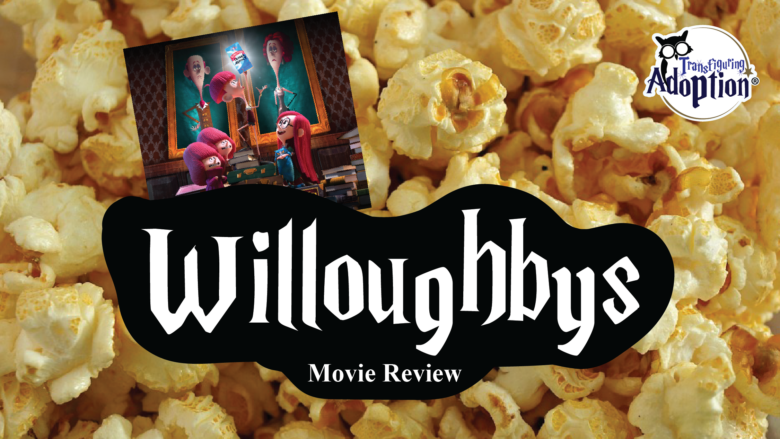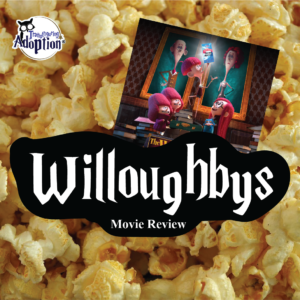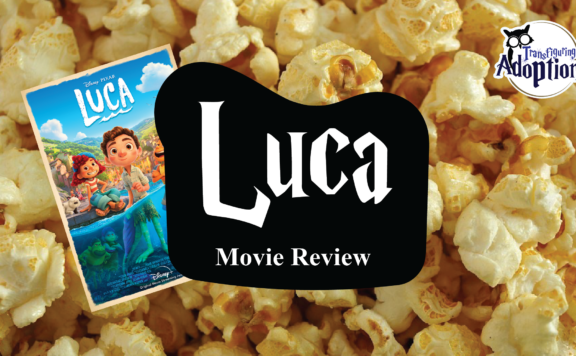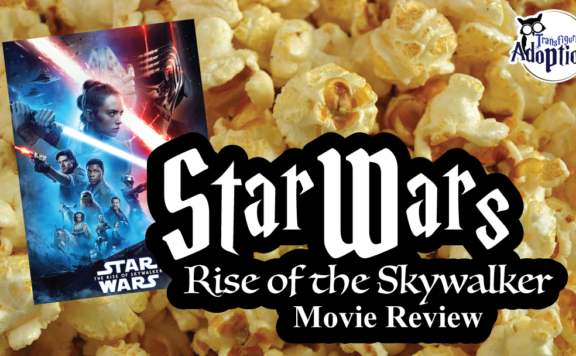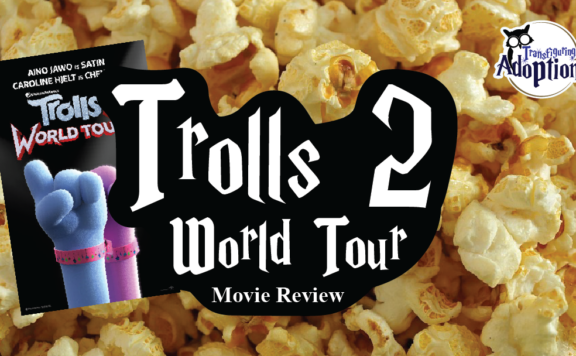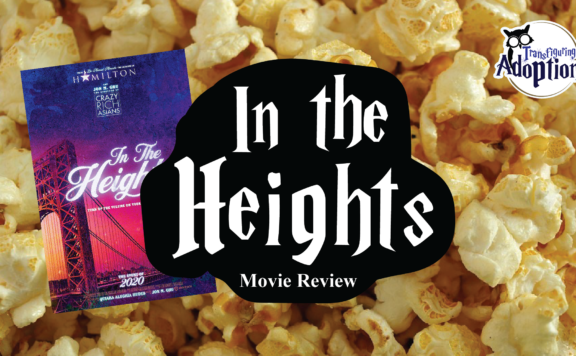Grade:
Transfiguring Adoption awarded this movie 1 Hoots out of 5 based on how useful it will be for a foster/adoptive family. [Learn more about our Hoot grading system here]
Movie Info:
From the Cover of The Willoughbys by Netflix:
“Convinced they’d be better off raising themselves, the Willoughby children hatch a sneaky plan to send their selfish parents on vacation. The siblings then embark on their own high-flying adventure to find the true meaning of family.”
I’d seen a number of concerned reviews regarding The Willoughby’s, the newest Netflix Original offering, so I went into it expecting there to be some trauma triggers. But even with that knowledge ahead of time, I was surprised by just how much concerning content there was, especially in the first 30 minutes of the movie (which I had to watch in 5-minute increments). The basic premise is that a group of siblings has ‘bad parents’ and decide they would be better off without them and send them on an extended vacation so they can take care of themselves instead. This premise is problematic as is, but it is quickly revealed that these parents aren’t just ‘bad’ they are abusive, and the children hope they will die on vacation.
The entire movie has a satirical overtone which in my opinion actually makes it worse somehow- that this abuse is seen as humorous. It seems to be attempting to capitalize on the success of works like A Series of Unfortunate Events, using a detached narrator (in this case, a cat) to tell a ‘tragic story’ that they advise you ‘not to watch’. However, it seems to lack the charm and redeeming qualities of other stories in this genre and the storyline, while it has potential, is poorly executed. Things improve some in the second act, and there are some heartfelt moments, but they are few and far between and much less memorable than the problematic scenes.
While the targeted age range of the film seems to be upper elementary and middle school aged children, we would recommend only watching with older children or those who have processed their trauma. There are many themes and situations that would lend themselves to good discussions about foster care and adoption, but the way they are presented are likely to cause more harm then good for children who have experienced trauma. If you are going to watch it, it is recommended to do so together with your children and perhaps plan to take breaks to discuss some of the more traumatic events.
** Spoilers Could Be Ahead **
How Is This Relevant To Adoption & Foster Care?
This movie directly addresses foster care and adoption, though it doesn’t use those specific words to describe it. Tim, Jane, and Barnaby(s) are the four unfortunate children to two parents who are described as ‘selfish’ (read- abusive). They frequently neglect their children – denying them food and love and even locking them in a cold basement when they misbehave. These acts are shown in a satirical manner but for our children who have likely experienced similar things at the hands of their caregivers it isn’t funny at all.
The children find an abandoned baby outside their doorstep at one point and decide to find her a home- which they are able to do by dropping her off on another doorstep- one where the resident decides to take her in. After seeing this, the children decide they would be better off if they were ‘orphans’ like the baby they found so they decide to send their parents away and take care of themselves. They plan a travel itinerary of dangerous locations and activities hoping that one of them will kill the parents so they will truly become orphans.
Enter: Nanny. For the first time, we someone in a caregiving role who truly seems to actually care for the children. The younger children quickly warm up to her- however Tim, the eldest, is mistrustful and assumes she is in league with his parents and means to cause them harm. These feelings mirror what many children who come into care experience. Because they have never had a positive caregiving relationship, they can be mistrustful of all adults and take the actions and words of a caring adult and misunderstand them because of this. Tim even goes as far as to call ‘orphan services’ to report her and as a result the children are taken away and placed in separate homes. Again, while the younger children seem to accept and adapt to their new caregivers, Tim continues to run away, even when placed with kind and well-meaning families- because he doesn’t trust them to care for him and is eventually placed in a juvenile detention facility. Foster and adoptive children will likely relate to Tim’s struggles here as well.
The siblings eventually decide that it would be better to go back to living with their abusive parents than to be separated and seek their caregivers out. Many children who get split up in foster care or adoption may feel this way at first too- that they would rather go back to their abusive home than to be separated from their families or to face the unknowns of their new situation.
The movie does end on a ‘happy’ note- the biological parents end up being killed in an accident and the children are adopted by Nanny (who we find out used to be in care herself). So throughout the movie we see what may mirror an adopted child’s journey- they start out with abusive caregivers, end up in the care of a good ‘foster’ caregiver but aren’t able to trust that relationship, end up split up by a child protection service agency and eventually find their way into a loving adoptive home.
Discussion Points:
- Trusting Caregivers
Tim is extremely distrustful of all adults throughout the movie. This is very common among children who have experienced abuse or neglect by a caregiver. Because the adults who are supposed to care for them don’t, that makes it hard for a child to trust that any adult has their best interests at heart. If all they know is abuse/neglect they have no frame of reference as to what a healthy caregiving relationship is supposed to look like. They may take words or actions of a caregiver that are meant with good intentions the wrong way, because in their experience adults are not to be trusted. The biggest example of this is in the movie is when Nanny comes to care for the Willoughby children while their parents are gone. She is kind and friendly towards them and seems to genuinely care about their well-being (and concerned about how their parents have treated them). However, Tim seems to take everything she says and does as proof that she’s dangerous and in league with his parents and wants to hurt him and his siblings. He even goes as far as to call child protective services to report her. Use these opportunities to talk to your children about how and when to trust adults and how to determine who should be trusted. You can discuss why Tim felt the way he did and what things he could look for in the future to help him figure out if an adult has his best interests at heart and use that as a way to start a conversation with your children about the people in their life they trust and how they figured that out. - Resilience
After showing all the ways the children are abused/neglected by their caregivers the narrator states that, “against all odds, the Willoughby children still had determination, imagination, and hope.” This can be a great opportunity to talk about resilience and the ways in which these children are able to be kind, caring, and intelligent people despite all they have been through (which may then facilitate discussion about your children’s own strengths and the ways that they are resilient). Anyone who has survived trauma has a great deal of resilience. This is that deep inner personality traits and strengths children have that allow them to get through difficult situations. Resilience is also improved by protective factors- positive experiences and relationships they may have the help to balance out the trauma. This may be in the form of strong sibling relationships (as is the case with the Willoughby children), relationships with teachers or friends, summers spent with a loving caregiver such as a grandparent, religious beliefs, hobbies etc. Talk about the personality traits and protective factors the Willoughbys have, as well as those that your own children have and how these things help them get through difficult times. - The Foster Care/Adoption Journey
While the movie has many triggers and problematic portrayals of themes and situations, it does a fairly good job of following a trajectory of the experience children may have with coming into care. We see children in an abusive home who experience being placed into temporary foster care with a positive caregiver, the process of learning to trust that caregiver, being removed from that care and separated from siblings, attempted reunification with their biological parents and then finally adoption. This can be a great means to launch a discussion about your child’s own journey and experience with foster care and adoption and how they got to where they are not and the various steps along the way. We also see several other examples of characters experiencing different trajectories such as Ruth being adopted fairly quickly as a baby and Nanny aging out of care without ever achieving permanency. Every journey is different, and this can be a great way to discuss what theirs looked like and/or what they hope or worry about for the future if they are still in care.
Cautionary Points:
-
- Abuse and Neglect from Primary Caregivers
At the very start of the movie we are told that Mom and Dad are very loving people and see them engaging in acts of love towards one another. However as soon as they have a baby (Tim), Dad takes it out into the hallway and leaves him there alone saying, “If you need love, I beg of you, find it elsewhere,” and the narrator tells us, “His loving parents had no love left over for Tim.” Despite this, we see them have three other children, none of whom they appear to care for. We see images of the parents eating an extravagant dinner while the children huddle in the kitchen hoping for scraps. The parents explain things as “we eat today’s food; you eat yesterday’s food” and seem appalled when Tim asks if they could have something to eat. The youngest twins share one sweater between them. It is very clear that their basic needs of food/shelter/safety are not being met.
Everything the children do or say is seen as an annoyance and inconvenience to the parents. They complain that the children are ‘always wanting’ and that they bother them with ‘childish needs’. The parents almost never call the children by name and say things like ‘that girl’ or ‘the creepy one’ in reference to them. And when the children ‘misbehave’ (such as asking for food) they are routinely punished by being locked in The Coal Bin (a dark and dirty basement area). At one point we even see the father lock them all out of the house at night as ‘punishment’.
- Asking for Help Shown Negatively
When the children are hungry and watching their parents eat dinner while they are not given any themselves, Jane tells her brother they need to find a way to eat and his response is that “I know we’re hungry, but Willoughbys do NOT beg for food.” In this case, he is trying to protect his siblings and feels that asking for food or other needs would make their parents angry and might lead to an abusive outburst. We see this pattern throughout the movie where Tim never wants to ask anyone for help and instead figure things out himself. This can be a common behavior with children from trauma, as in their experience adults cannot be trusted to actually help. Because the Willoughby children do often succeed at their endeavors without adult help, it may be a point to keep an eye on with your children if they have this tendency as it shows this in a somewhat positive light.
- Revenge/Plotting to Hurt Others
At one point the children get fed up with their treatment and decide they would be better off without their parents. They come up with a plan to send their parents on a trip to various dangerous locations around the world with the hopes that their parents will die. During this scene we hear Tim describe the various dangers and how harm might befall them with no real concern for their welfare. For some children who have experienced abuse they may harbor negative and potentially violent feelings towards those caregivers and this plot point in the movie may send the message to them that hoping for harm to befall others is acceptable.
- Negative Language to Refer to Children in Care
The movie uses the term ‘orphan’ with extreme frequency- they use it when referencing Baby Ruth, calling her ‘the orphan’ (and in once instance ‘the beast’). They also talk about wanting to be orphans or how they aren’t ‘real orphans’ since their parents are alive. This word tends to have pretty negative connotations these days and may be upsetting for children who are in care or adopted.
- Moments of Mild Peril/Cartoon Violence
When baby Ruth is brought into the home there is a scene where she gets loose and causes havoc in the living room- including a moment where she seems to have been flung into the fireplace. However, she reappears unscathed a moment later. Tim and Jane design a catapult to get rid of Nanny and instead Tim gets launched through an open window into the air. He is also, however, unharmed. The parents experience several dangerous scenarios on their ‘vacation’ which almost end in peril, but the parents always manage to escape it. There is also a scene where the children booby-trap their house to keep potential buyers from wanting to live there. All of this is portrayed in a cartoonish way and with very little real fear that bad things will actually happen but could be upsetting or scary to some children.
- Risk-Taking Behaviors
The Willoughby children frequently engage in risky activities during the movie- there is a scene where they walk through traffic without looking, the breakthrough a fence with a ‘no-trespassing’ sign and fly a homemade dirigible through the sky. As with the moments of violence, these are all written off with a humorous tone and the children never seem to be in any real danger from these activities. However, many children with traumatic pasts tend to engage in risk-taking behaviors. They often didn’t have caregivers to tell them not to, or they never experienced safety at home, so they have a lessened understanding of the dangers of these activities. Seeing characters in a movie engage in these behaviors may send a message to them that it’s okay to do such things.
- Abandonment/Rejection of Children
Aside from the abuse and neglect by the parents to the Willoughby children throughout the film, there are several examples of clear rejection and abandonment as well. The children find Baby Ruth in a metal cage dropped by their garden gate and the movie never addresses where she came from or what happened to her before then. When Baby Ruth is brought to the parents they react with disgust and anger and insist the children get rid of her. The children do this by dropping her off at the doorstep of a candy factory with a stranger. The Candy Man ends up deciding to keep her, but he discusses that his initial thought was to call Orphan Services and have them come get her. We learn that Nanny was an orphan as a child, and we are told “we tried to find her a home, but no one wanted her.” Finally, towards the end of the movie the children seek out their parents on a mountain and beg for their parents to take them back and tell them it’s okay if they don’t love them, but they just want to have parents again. Their parents basically laugh in their faces and steal their dirigible leaving them stranded on the mountaintop. All of these situations may be difficult for foster and adoptive children to watch, as they have likely experienced these feelings of abandonment by a caregiver on some level. The part where we learn Nanny never found a forever home as a child may be especially sad for children who are in foster care and have worries that they will never get adopted or find permanency.
- Negative Portrayal of Child/Social Services
When we meet Candy Man, he says he considered calling ‘orphan services’ (CPS) to come and get Ruth. Nanny is appalled and tells him that “giving a baby to them is like locking a puppy in a cage”. After Tim reports Nanny to orphan services, they rush to the house to remove the children from her care. This is shown in a scary way with dozens of cars pulling up to the house and militant agents marching in and surrounding the place before seeming to almost arrest Nanny and then place the children in three cars to send them to separate homes. Later, after several instances of running away, Tim ends up put into a juvenile detention facility which appears to be a prison cell. While it is not actually done in this way in reality, for many children this depiction may be what if feels like to have been removed from their home. To them, they are being ‘attacked’ and taken away from their parents and siblings and it feels very scary and unsettling. For children who were removed from a home in the past, this scene in the movie is likely to be very upsetting and stressful for them to watch. Also, many children may have negative feelings towards social services agencies because they view them as the people who took them away from their family. Seeing them portrayed in a negative and scary way may exacerbate those feelings.
- Siblings Separated
When Orphan Services comes to remove the children from Nanny’s care, they separate them and send them each to different homes stating, “fighting children must be separated- for your own good”. So far throughout the movie the only thing the Willoughbys seem to have going for them is that they have each other. Then they lose the only caregiver who has ever shown them kindness which is a trauma in itself but instead of being able to process this together they are separated. In many foster care cases this ends up happening for a number of reasons but can be very hard on the kids. For those who have siblings who are not in the same home as them, this scene and the montage of their new homes that follows is likely to be very upsetting to watch.
- Parent Death
At the end of the film we see Mom and Dad fall from the dirigible in an accident and they are presumed to be dead. It turns out that they survived the fall only to be eaten by a crocodile. We don’t know whether they survive this mishap or not, but the children process the event as if their parents have died. Even though they treated the children poorly, it’s still difficult to watch your caregivers die and the scene may elicit complicated feelings in children who have experienced similar situations.
About the Author: Jenn Ehlers
Jenn is a central Virginia native who received her BA in Psychology from the University of Virginia in 2012. Since then she has worked for a local mental health agency and the Department of Social Services in various capacities and has been involved in her community’s efforts to create a Trauma Informed Network. Currently Jenn works in vocational rehab and mentors youth in foster care. When she isn’t working, Jenn enjoys writing stories, anything and everything Harry Potter, and spending time with her niece and nephew.
**Transfiguring Adoption is a nonprofit organization seeking to nurture growth in foster and adoptive families by giving a HOOT about their families. Transfiguring Adoption does not intend for its reviewers nor its review to be professional, medical or legal advice. These reviews and discussion guides are intended to help parents to better be able to connect and understand their children who come from traumatic backgrounds.
